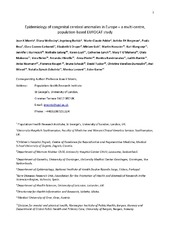Epidemiology of congenital cerebral anomalies in Europe: a multicentre, population-based EUROCAT study
Morris, Joan K.; Wellesley, Diana G.; Barisic, Ingeborg; Addor, Marie-Claude; Bergman, Jorieke E. H.; Braz, Paula; Cavero-Carbonell, Clara; Draper, Elizabeth S.; Gatt, Miriam; Haeusler, Martin; Klungsøyr, Kari; Kurinczuk, Jennifer J.; Lelong, Natalie; Luyt, Karen; Lynch, Catherine; O'Mahony, Mary T.; Mokoroa, Olatz; Nelen, Vera; Neville, Amanda J.; Pierini, Anna; Randrianaivo, Hanitra; Rankin, Judith; Rissmann, Anke; Rouget, Florence; Schaub, Bruno; Tucker, David F.; Verellen-Dumoulin, Christine; Wiesel, Awi; Zymak-Zakutnia, Natalia; Lanzoni, Monica; Garne, Ester
Peer reviewed, Journal article
Accepted version

Permanent lenke
https://hdl.handle.net/1956/22715Utgivelsesdato
2019Metadata
Vis full innførselSamlinger
Originalversjon
https://doi.org/10.1136/archdischild-2018-316733Sammendrag
Objectives: To describe the epidemiology and geographical differences in prevalence of congenital cerebral anomalies in Europe. Design and setting: Congenital cerebral anomalies (International Classification of Diseases, 10th Revision code Q04) recorded in 29 population-based EUROCAT registries conducting surveillance of 1.7 million births per annum (29% of all European births). Participants: All birth outcomes (live births, fetal deaths from 20 weeks gestation and terminations of pregnancy after prenatal diagnosis of a fetal anomaly (TOPFA)) from 2005 to 2014. Main outcome measures: Prevalence, proportion of associated non-cerebral anomalies, prenatal detection rate. Results: 4927 cases with congenital cerebral anomalies were identified; a prevalence (adjusted for under-reporting) of 9.8 (95% CI: 8.5 to 11.2) per 10 000 births. There was a sixfold difference in prevalence across the registries. Registries with higher proportions of prenatal diagnoses had higher prevalence. Overall, 55% of all cases were liveborn, 3% were fetal deaths and 41% resulted in TOPFA. Forty-eight per cent of all cases were an isolated cerebral anomaly, 25% had associated non-cerebral anomalies and 27% were chromosomal or part of a syndrome (genetic or teratogenic). The prevalence excluding genetic or chromosomal conditions increased by 2.4% per annum (95% CI: 1.3% to 3.5%), with the increases occurring only for congenital malformations of the corpus callosum (3.0% per annum) and ‘other reduction deformities of the brain’ (2.8% per annum). Conclusions: Only half of the cases were isolated cerebral anomalies. Improved prenatal and postnatal diagnosis may account for the increase in prevalence of congenital cerebral anomalies from 2005 to 2014. However, major differences in prevalence remain between regions.
